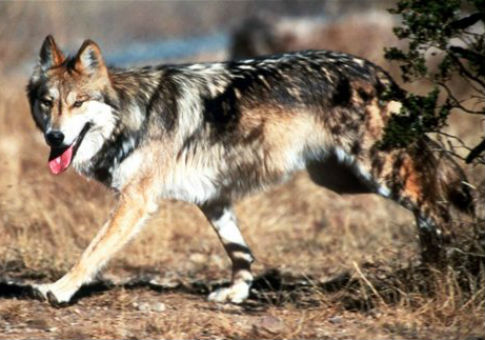Interior Department officials placed the welfare of wolves over public safety, neglecting to inform residents when wolves were roaming and killing cattle in New Mexico, according to a new audit.
An official in charge of the Fish and Wildlife Service’s Mexican Gray Wolf Recovery Program, which was established to conserve the species, was found to be protecting wolves she considered "genetically valuable," even though they posed a danger to residents in the area.
The agency’s inspector general released an audit last month detailing how the former program coordinator covered up complaints against a wolf that posed a "human safety hazard."
Team employees in Catron County "deliberately avoided documenting complaints to protect certain wolves," the inspector general found. Allegations made by the Catron County Board of Commissioners were confirmed by Fish and Wildlife Service employees.
"As an example, the county employee described an incident involving one male wolf, serial number M1133, that had been captured in a residential area of Reserve, NM (the Catron County seat), after numerous complaints," the inspector general said. "[The Mexican Gray Wolf Recovery Program] said that wolf M1133 could be paired with a female and released because [the program] considered the wolf genetically valuable and stated that it had no documented history of nuisance behavior. [Interagency Field Team] IFT personnel, including the former IFT coordinator, met with ranchers and county officials to discuss the release plans."
The coordinator said the wolf could be released since it had "no nuisance complaints" against it, despite being informed that the wolf was "extremely habituated" and "a human safety hazard."
The wolf was released "despite strong opposition from the county." It then killed cattle in another community.
The former coordinator was described by other employees, including a senior wolf biologist, as "‘overly passionate’ about individual wolves and thus reluctant to remove them from the wild when it was appropriate to do so."
One employee said the coordinator was "more concerned for the individual [wolf] than the species." She was also seen "crying when one of the wolves in the program had to be killed."
"The county commissioner and the county employee alleged that FWS officials focused on wolf welfare rather than public safety," the inspector general said. "We also spoke to several Catron Country residents who said that IFT did not notify them about the presence of wolves, did not properly manage nuisance wolves, and falsified or concealed wolves’ locations, which caused them to be concerned about public safety."
The Mexican Gray Wolf was added to the endangered species list in 1976. Since then, the Fish and Wildlife Service has overseen a program to grow the population and monitor the wolves to prevent livestock killings.
The former coordinator of the program cited in the report took up her position in January 2011 and was transferred within the agency in August 2013.
The official first denied that she gave certain wolves "preferential treatment" despite their danger to the community, but eventually admitted to the inspector general that she "did treat them ‘differently’ from other wolves."
"She said that she gave genetically valuable wolves more care, allowed their nuisance behavior to continue, and provided them more opportunities to breed," according to the inspector general.
Other allegations of misconduct by program officials included not notifying the public when wolves were roaming near their homes and removing cattle carcasses to prevent ranchers from discovering them.
"One resident told us that IFT members did not tell people in her area that the wolf had been seen there even though IFT had been searching for the wolf several days before its capture," the inspector general said. "She complained that IFT members should have notified residents at the start of the search to avoid putting them and their children, pets, and livestock at unnecessary risk."
Another rancher said the program told him there were no wolves in the area, even though the rancher could see a wolf pack feasting on an elk carcass just outside his back yard.
"One landowner told us that he believed he had seen where [program] personnel had removed livestock carcasses from his property, and he had heard about statements made by [program] staff that caused him to suspect they removed dead livestock to protect wolves from scrutiny," the inspector general said. "The landowner added that he had seen numerous locations on his property where a bloody struggle associated with a suspected livestock depredation had taken place and that he saw tire tracks in the dirt nearby but no carcass."
Allegations of misconduct go back to 2000, when a rancher said 36 of his cows and 71 calves were killed by wolves over a 5 year period. The program only reimbursed the rancher for 7 cows and 15 of the calves.
"A third rancher said that depredations have cost his ranching business several hundred thousand dollars over the years," the inspector general said. "He said that in 2005, he lost 109 animals but was only reimbursed for 18."
